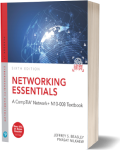Networking Essentials - A CompTIA Network+ N10-008 Textbook
Networking
Book Details
Book Title
Networking Essentials - A CompTIA Network+ N10-008 Textbook 6th Edition Edition: 6
Author
Jeffrey S. Beasley Piyasat Nilkaew
Publisher
Pearson IT Certification
Publication Date
2021
ISBN
9780137455829
Number of Pages
851
Language
English
Format
File Size
27.2MB
Subject
Computer Networking
Table of Contents
- Cover
- Title
- Copyright
- Contents At A Glance
- Contents
- Introduction
- Chapter 1. Introduction to Computer Networks
- Chapter Outline
- Objectives
- Key Terms
- 1-1 Introduction
- 1-2 Network Topologies
- 1-3 The OSI Model
- 1-4 The Ethernet LAN
- 1-5 Home Networking
- 1-6 Assembling an Office LAN
- 1-7 Testing and Troubleshooting a LAN
- Summary
- Questions and Problems
- Chapter 2. Physical Layer Cabling: Twisted-Pair
- Chapter Outline
- Objectives
- Key Terms
- 2-1 Introduction
- 2-2 Structured Cabling
- 2-3 Twisted-Pair Cable
- 2-4 Terminating Twisted-Pair Cables
- 2-5 Cable Testing and Certification
- 2-6 10 Gigabit Ethernet over Copper
- 2-7 Troubleshooting Cabling Systems
- Summary
- Questions and Problems
- Chapter 3. Physical Layer Cabling: Fiber Optics
- Chapter Outline
- Objectives
- Key Terms
- 3-1 Introduction
- 3-2 The Nature of Light
- 3-3 Fiber Attenuation and Dispersion
- 3-4 Optical Components
- 3-5 Optical Networking
- 3-6 Safety
- 3-7 Troubleshooting Fiber Optics: The OTDR
- Summary
- Questions and Problems
- Chapter 4. Wireless Networking
- Chapter Outline
- Objectives
- Key Terms
- 4-1 Introduction
- 4-2 The IEEE 802.11 Wireless LAN Standard
- 4-3 802.11 Wireless Networking
- 4-4 Bluetooth, WiMAX, RFID, and Mobile Communications
- 4-5 Configuring a Point-to-Multipoint Wireless LAN: A Case Study
- 4-6 Troubleshooting Wireless Networks
- Summary
- Questions and Problems
- Chapter 5. Interconnecting the LANs
- Chapter Outline
- Objectives
- Key Terms
- 5-1 Introduction
- 5-2 The Network Bridge
- 5-3 The Network Switch
- 5-4 The Router
- 5-5 The Console Port Connection
- 5-6 Interconnecting LANs with the Router
- 5-7 Interconnecting LANs and WANs
- Summary
- Questions and Problems
- Chapter 6. TCP/IP
- Chapter Outline
- Objectives
- Key Terms
- 6-1 Introduction
- 6-2 The TCP/IP Layers
- 6-3 Number Conversion
- 6-4 IPv4 Addressing
- 6-5 Subnet Masks: Subnetting and Supernetting
- 6-6 Supernetting, CIDR Blocks, and VLSM
- 6-7 IPv6 Addressing
- Summary
- Questions and Problems
- Chapter 7. Introduction to Router Configuration
- Chapter Outline
- Objectives
- Key Terms
- 7-1 Introduction
- 7-2 Router Fundamentals
- 7-3 The Router’s User EXEC Mode (Router>)
- 7-4 The Router’s Privileged EXEC Mode (Router#)
- 7-5 Configuring the Network Interface: Auto-negotiation
- 7-6 Troubleshooting the Router Interface
- Summary
- Questions and Problems
- Chapter 8. Introduction to Switch Configuration
- Chapter Outline
- Objectives
- Key Terms
- 8-1 Introduction
- 8-2 Introduction to VLANs
- 8-3 Introduction to Switch Configuration
- 8-4 Spanning Tree Protocol
- 8-5 Power over Ethernet
- 8-6 Troubleshooting the Switch Interface
- Summary
- Questions and Problems
- Chapter 9. Routing Protocols
- Chapter Outline
- Objectives
- Key Terms
- 9-1 Introduction
- 9-2 Static Routing
- 9-3 Dynamic Routing Protocols
- 9-4 Distance Vector Protocols
- 9-5 Configuring RIP and RIPv2
- 9-6 Link State Protocols
- 9-7 Configuring the Open Shortest Path First (OSPF) Routing Protocol
- 9-8 Configuring Enhanced Interior Gateway Routing Protocol (EIGRP)
- 9-9 Internet Routing with Border Gateway Protocol (BGP)
- 9-10 IPv6 Routing
- Summary
- Questions and Problems
- Chapter 10. Managing the Network Infrastructure
- Chapter Outline
- Objectives
- Key Terms
- 10-1 Introduction
- 10-2 Domain Name and IP Address Assignment
- 10-3 IP Address Management with DHCP
- 10-4 Scaling a Network with NAT and PAT
- 10-5 Domain Name System (DNS)
- 10-6 Network Management Protocols
- 10-7 Analyzing Network Traffic
- 10-8 Network Analyzer: Wireshark
- 10-9 Analyzing Computer Networks: FTP Data Packets
- 10-10 Troubleshooting IP Networks
- Summary
- Questions and Problems
- Chapter 11. Network Security
- Chapter Outline
- Objectives
- Key Terms
- 11-1 Introduction
- 11-2 Intrusion: How Attackers Gain Control
- 11-3 Denial-of-Service
- 11-4 Security Software and Hardware
- 11-5 Managing Network Access
- 11-6 Router Security
- 11-7 Switch Security
- 11-8 Wireless Security
- 11-9 Remote Access and VPN Technologies
- 11-10 Physical Security
- Summary
- Questions and Problems
- Chapter 12. Cloud Computing and Virtualization
- Chapter Outline
- Objectives
- Key Terms
- 12-1 Introduction
- 12-2 Virtualization
- 12-3 Cloud Computing
- 12-4 Enterprise Storage
- Summary
- Questions and Problems
- Chapter 13. Codes and Standards
- Chapter Outline
- Objectives
- Key Terms
- 13-1 Introduction
- 13-2 Safety Standards and Codes
- 13-3 Industry Regulatory Compliance
- 13-4 Business Policies and Best Practices
- 13-5 Business Continuity and Disaster Recovery
- Summary
- Questions and Problems
- Glossary
- Index
